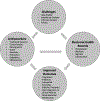Biomarkers for Progression in Diabetic Retinopathy: Expanding Personalized Medicine through Integration of AI with Electronic Health Records
- PMID: 33734908
- PMCID: PMC8122081
- DOI: 10.1080/08820538.2021.1893351
Biomarkers for Progression in Diabetic Retinopathy: Expanding Personalized Medicine through Integration of AI with Electronic Health Records
Abstract
The goal of personalized diabetes eye care is to accurately predict in real-time the risk of diabetic retinopathy (DR) progression and visual loss. The use of electronic health records (EHR) provides a platform for artificial intelligence (AI) algorithms that predict DR progression to be incorporated into clinical decision-making. By implementing an algorithm on data points from each patient, their risk for retinopathy progression and visual loss can be modeled, allowing them to receive timely treatment. Data can guide algorithms to create models for disease and treatment that may pave the way for more personalized care. Currently, there exist numerous challenges that need to be addressed before reliably building and deploying AI algorithms, including issues with data quality, privacy, intellectual property, and informed consent.
Keywords: Artificial intelligence; biomarkers; diabetic retinopathy; electronic health records; personalized medicine.
Conflict of interest statement
DISCLOSURE STATEMENT
The authors declare that they have no financial interests related to this research
Similar articles
-
Artificial Intelligence Algorithms in Diabetic Retinopathy Screening.Curr Diab Rep. 2022 Jun;22(6):267-274. doi: 10.1007/s11892-022-01467-y. Epub 2022 Apr 19. Curr Diab Rep. 2022. PMID: 35438458 Review.
-
How Can Artificial Intelligence Be Implemented Effectively in Diabetic Retinopathy Screening in Japan?Medicina (Kaunas). 2024 Jan 30;60(2):243. doi: 10.3390/medicina60020243. Medicina (Kaunas). 2024. PMID: 38399532 Free PMC article. Review.
-
Autonomous Artificial Intelligence in Diabetic Retinopathy: From Algorithm to Clinical Application.J Diabetes Sci Technol. 2021 May;15(3):695-698. doi: 10.1177/1932296820909900. Epub 2020 Mar 4. J Diabetes Sci Technol. 2021. PMID: 32126819 Free PMC article.
-
Artificial Intelligence in the assessment of diabetic retinopathy from fundus photographs.Semin Ophthalmol. 2020 Nov 16;35(7-8):325-332. doi: 10.1080/08820538.2020.1855358. Epub 2021 Feb 4. Semin Ophthalmol. 2020. PMID: 33539253 Review.
-
Cost-effectiveness of artificial intelligence screening for diabetic retinopathy in rural China.BMC Health Serv Res. 2022 Feb 25;22(1):260. doi: 10.1186/s12913-022-07655-6. BMC Health Serv Res. 2022. PMID: 35216586 Free PMC article.
Cited by
-
Global trends and performances in diabetic retinopathy studies: A bibliometric analysis.Front Public Health. 2023 Apr 13;11:1128008. doi: 10.3389/fpubh.2023.1128008. eCollection 2023. Front Public Health. 2023. PMID: 37124794 Free PMC article.
-
Revolutionizing diabetic retinopathy screening and management: The role of artificial intelligence and machine learning.World J Clin Cases. 2025 Feb 16;13(5):101306. doi: 10.12998/wjcc.v13.i5.101306. World J Clin Cases. 2025. PMID: 39959767 Free PMC article.
-
Interpretability of Clinical Decision Support Systems Based on Artificial Intelligence from Technological and Medical Perspective: A Systematic Review.J Healthc Eng. 2023 Feb 3;2023:9919269. doi: 10.1155/2023/9919269. eCollection 2023. J Healthc Eng. 2023. PMID: 36776958 Free PMC article.
References
MeSH terms
Substances
Grants and funding
LinkOut - more resources
Full Text Sources
Other Literature Sources
Medical

